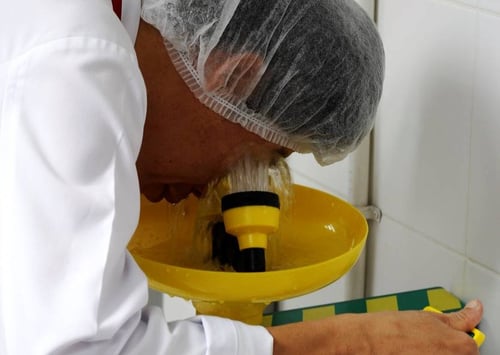While at work in a pharmaceutical company in Ireland, a worker incorrectly used acetone in a chemical experiment and sparked a horrific explosion. The chemical explosion caused a number of tragedies, including the worker passing away from severe chemical burns, and his co-worker being seriously injured. An ambulance attending the scene had to be later de-commissioned due to the damage it sustained from the chemical explosion. The ultimate tragedy of this incident is that the two staff members that rushed to the main floor to shut down the experiment, put themselves in direct line with the explosion. Had they stayed in the control room, they may have remained safe.
While this incident is a reminder of just how dangerous chemicals in the workplace can be, it’s also an example of how accidents can be prevented. If the pharmaceutical company had undertaken more stringent risk control measures — and had trained their staff in emergency procedures — the outcome of this incident may have been very different.
This post will focus on the safe handling of chemicals in the workplace. We’ll be offering a range of control measures that you can easily implement in your own organisation. While the staff in the above example were undertaking a complex chemical experiment — maybe a little more complex than chemical usage at your workplace — the real issue is that they hadn’t been adequately trained to safely handle the chemicals or deal with an emergency situation.

Ensuring staff know how to handle chemicals safely and deal with emergency situations is vital for the safety of your team and your organisation.
How Can You Use Chemicals Safely At Work?
Most workplaces contain hazardous chemicals. And whether you’re using hazardous chemicals for manufacturing, metal fabrication, petroleum processing or simply just for cleaning the floors, there is a risk involved.
However, your job is to minimise the likelihood that someone at your workplace could be harmed by those chemicals.
Usually, the best place to start when learning to safely use chemicals in any workplace is with the Safety Data Sheets (SDS). An SDS arrives with each chemical that is purchased from the supplier.
Safety Data Sheets (SDS)
The Safety Data Sheet (SDS) is a mandatory document that describes a hazardous substance and details advice on how to use it safely. Every SDS contains information about:
- The chemical properties
- Hazards
- Health effects
- Mandatory labeling and signage
- Exposure control and required PPE
- Safe handling and storage
- First aid
- Emergency procedures
- Disposal
By starting with the SDS, you can quickly identify the type of chemicals you are using, as well as the risks and hazards associated with each chemical product.

Refer to your SDS for details about the chemical properties, hazards and safe handling and storage procedures.
Hazard Types Associated With Chemicals
Let’s now take a look at six different types of hazardous chemicals — and the hazards that are associated with each of them:
Explosives:
Explosives are volatile dangerous goods which pose a serious threat to the health and safety of staff, emergency responders, building occupants, chemical waste handlers, and disposal companies.
Check the SDS closely to see how they become explosive (subjected to heat, light, friction or mechanical shock) and make sure they are handled carefully (train your staff in correct manual handling procedures). You must also ensure that explosives are stored and dispensed away from ignition sources. Explosives must also be kept away from incompatible substances to avoid violent chemical reactions.
Because there is still a lot of uncertainty regarding the hazards and safe handling of explosive chemicals, it’s vital that you train your staff in emergency procedures.
Consider the following questions: What’s the worst-case scenario if an explosion did occur? How would staff respond? Remember the two workers killed in Ireland because they had no idea what to do in a chemical emergency?
Don’t let a horrific (and preventable) incident, such as an explosion, happen at your workplace.
Flammables:
Flammable chemicals can quickly ignite and burn at normal working temperatures. You find flammable liquids in just about every workplace, whether they’re used as fuels, solvents, thinners, cleaners, adhesives, paints, waxes or polishes.
They key consideration when storing flammables is that they are kept and dispensed away from heat and ignition sources.
Flammables are often toxic and corrosive, so you should also check the SDS to find out the other hazards associated with the chemical.
Oxidisers:
Oxidisers are dangerous for three key reasons:-
- They start fires quickly and make them more intense
- They can start a fire without a spark or a flame
- They can cause substances that usually burn slowly to burn faster and hotter
Oxidisers must be stored away from other chemicals, as well as heat and ignition sources.
Developing safe handling procedures is essential because many oxidisers can react dangerously to shock and friction. Remember also that oxidisers can be toxic and corrosive — so check each SDS closely.

Oxidisers are dangerous chemicals which can start a blaze without a spark or flame.
Self-Reactive Chemicals:
Self-reactive chemicals are particularly dangerous because they can detonate, explode or catch fire even without oxygen.
Sometimes all it takes is sunlight, slight heat, friction, mechanical shock or contamination with incompatible materials. Read the SDS carefully and follow the advice we’ve given (see the above section) for explosives.
Along with explosives, it’s critical that your organisation has clear manual handling procedures. Your staff must be trained in emergency procedures, so they can quickly act to control and minimise casualties, in the event of an explosion.
If friction is a source of ignition, safe storage of the self-reactive chemical is critical.
Toxic Substances:
Toxic chemicals are poisonous to our human bodies. They can cause harm by being swallowed, absorbed and inhaled — or having direct contact with our skin.
Toxic chemicals nearly always require the use of personal protective equipment (PPE) to maintain the health and safety of staff. You should check the SDS of your toxic substances to make sure you have the right PPE onsite.
However, keep in mind that it’s not enough just to have PPE in your workplace. You must also train staff on how to use PPE properly. They must also understand the procedures for emergency decontamination and first aid.
It’s likely that your workplace will need to install eyewash stations, breathing apparatus and first aid equipment if you’re working with toxic substances.

The provision of emergency decontamination equipment is essential when working with hazardous substances like toxic chemicals.
Corrosives:
Corrosives are very dangerous because they attack and destroy body tissue. Like toxins, corrosive chemicals can enter the body through breathing, ingestion or making direct contact with the skin or eyes.
Please make sure you have adequate PPE onsite, and that all of your staff actually use it when handling corrosives. Afterall, safety glasses and masks are useless if they’re left hanging on the wall.
If your organisation is holding acids and bases, you must also practice the rules of segregation. These types of chemicals must never be kept together, as it can result in dangerous chemical reactions that can harm people and property.
Again, check the SDS for each chemical, so you can systematicallly address each of the hazards and safety concerns.
IMPORTANT: For all types of hazardous chemicals, you should also create a master register. This is to assist staff and emergency services in understanding what chemicals are being used and stored in your workplace.
Why is A Hazardous Chemical Register Important?
A hazardous chemical register is a record all the hazardous substances used at your workplace.
This register must contain the SDS for each substance. It must also be accessible to all your workers.
The register will contain critical information about emergency responses, poisons information, first aid and treatment. Therefore, it’s not enough to place the SDS in a filing cabinet and send a memo. Your staff need to know exactly where the SDS are located — and be able to easily grab them in the event of an emergency.
NOTE: The Hazardous Chemical Register should also be easily accessible to emergency personnel responding to a workplace accident or fire. An explosive chemical or flammable substance impacts their safety, too.
Ensuring Safe Handling Of Workplace Chemicals
Are you confident that your staff have the knowledge to safely use and handle hazardous substances? Would your team know exactly what to do in the event of a chemical emergency?
We strongly recommend downloading and reading our free eBook, How To Manage The Risk Of Hazardous Chemicals In The Workplace. We’ve written it in an easy-to-understand format so you’ll learn exactly how to meet your obligations under Australian WHS laws (and make your workplace safer too). Remember, if you use, handle or store any hazardous substances at your workplace (even the stuff you use for cleaning floors), you have an obligation to ensure the safety of your worker as well as visitors and contractors.
And finally, don’t forget those two workers in Ireland who ran into a chemical explosion because they had not been trained in emergency procedures. Don’t let this happen at your workplace! For more information on how to manage the risks associated with hazardous chemicals, download our FREE eBook by clicking on the image below.
Joining the team as a Dangerous Goods Storage Consultant, Melissa Hampton became Storemasta's Marketing Manager in late 2021. With extensive knowledge and experience in chemical compliance, Melissa is responsible for leading the Marketing team and helping shape their marketing strategy. In her spare time, you can find Melissa hiking, swimming and enjoying the great outdoors in beautiful north-west Tasmania.

